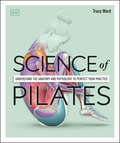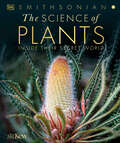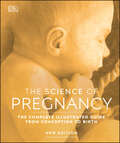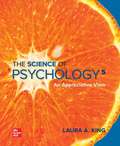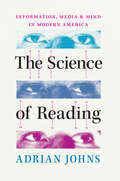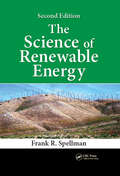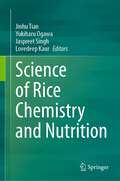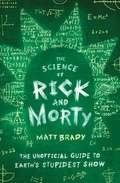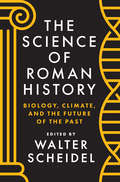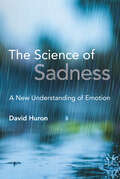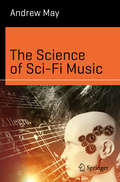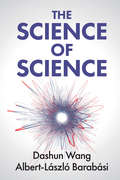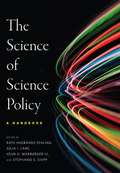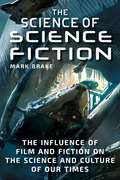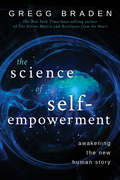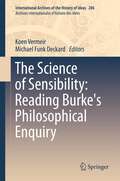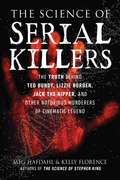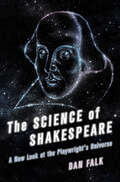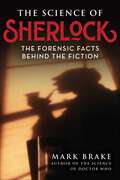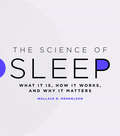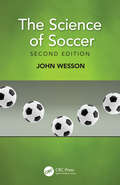- Table View
- List View
Science of Pilates: Understand the Anatomy and Physiology to Perfect Your Practice (DK Science of)
by Tracy WardExplore the science behind over 50 pilates exercises to master each movement with confidence and control. DK brings you a ground-breaking health book that will help you revitalize your workouts and perfect your Pilates practice, by understanding the muscle action, breathwork and techniques required, every step of the way. Did you know that performing Pilates can strengthen your core, improve flexibility and posture, and help to reduce stress and anxiety at the same time? Backed by scientific research, learn how Pilates exercises benefit every system in the body. Science of Pilates reveals the facts with annotated artworks that show the mechanics, the angles, how your blood flow and respiration are affected, the key muscle and joint actions working below the surface of each exercise, safe alignment, and much more!Go on a journey of self-discovery to explore: - Specially commissioned CGI artworks depict all the main Pilates exercises with variations that add or reduce challenge. - Artworks detail the mechanics of each exercise, correct body posture, the muscles involved and how they engage to perform movements.- Illustrations featuring color-coding to highlight how the muscles, ligaments, and joints engage, stretch, and relax to perform each exercise.- Pilates programs tailored to different abilities and aims.- Suggested practices with a progressive increase in challenge over weeks and months.- Easy-to-follow infographics help explain the hard science behind why Pilates training is so effective and what beneficial physical adaptations it can bring.Set out to unearth the facts behind the pseudo-science fads, The Science of Pilates is an approachable, entertaining and easy-to read fitness guide for those seeking self-development backed up by solid scientific evidence. The popular question and answer format brings immediacy to the information provided, and the highly visually illustrations truly bring the science to life in a contemporary and accessible way. At DK, we believe in the power of discovery. So why stop there? If you like Science of Pilates, then why not try Science of Yoga to help you better understand yoga anatomy in order to perfect your practice and poses, or Science of Strength Training to support you in your journey to build you strongest body. Complete the collection today!
The Science of Plants: Inside Their Secret World (DK Secret World Encyclopedias)
by DKCombining graceful design and beautiful imagery, this book provides an elegant introduction to the plant kingdom.Discover the extraordinary diversity of the plant world—and how plants work—with this photographic celebration of the trees, flowers, and foliage plants that share our planet. From tiny mosses and delicate ferns to vibrant blooms and stately palms, The Science of Plants invites you to explore the plant kingdom from the ground up, and from root to leaf tip. DK&’s elegant introduction to botany is packed with sumptuous photos and crystal-clear artworks that explain the mechanics of photosynthesis, why leaves change color, how cacti store water, and how seeds know when to grow. Filled with fascinating stories of how plants protect themselves from predators, and how flowers use color and scent to interact with—and manipulate—the creatures around them, The Science of Plants is a fresh and engaging introduction to the mysterious inner workings of the plant world.
The Science of Pregnancy: The Complete Illustrated Guide From Conception to Birth (DK Human Body Guides)
by DKFollow the amazing journey of the earliest stages of human life, with month-by-month development shown in unprecedented detail.The complex concepts and processes of emerging life are demystified with clear, jargon-free text, while exclusive 3-D images, extraordinary photographs, and detailed illustrations illuminate every aspect of human pregnancy. The largest section of the book examines the development of the baby in the womb and the parallel changes in the mother's body. Special 3-D art, illustrations, scans, and photographs show exactly how a baby changes and grows during pregnancy and how the female body adapts to carry it. A section on labor and birth explains these processes with step-by-step illustrations and easy-to-grasp text. The Science of Pregnancy also looks at the nature of human pregnancy, including how it evolved, and explores the anatomy and physiology of both the male and female reproductive systems. The mysteries of DNA and genetics are unraveled and explained in clear, illustrated detail, including patterns of inheritance and the interplay of genes and environment. Also provides straightforward, illustrated information on possible problems before, during, and after birth.
The Science of Psychology: An Appreciative View
by Laura A. KingThis book communicates the nature and breadth of psychology -and its value as a science - with an emphasis on why things go right. With primary goals of teaching students to think like psychological scientists and focusing on the understanding of human strengths and capacities, health, and wellness, the book cultivates students’ appreciation for how extensively psychology applies to their lives.
The Science of Psychology (2nd Edition)
by Bruce HinrichsWe begin our journey through the scientific discipline of psychology with an overview of the many vast dimensions of this fascinating field, and a look at the experimental methods that psychologists use. Here you will find a description of the many diverse subfields of psychology and of the scientific methods that provide the discipline of psychology with the tools for meeting its goals - to describe, explain, predict, and control the behavior and mental processes of animals, including, of course, humans.
The Science of Reading: Information, Media, and Mind in Modern America
by Adrian JohnsFor the first time, the story of how and why we have plumbed the mysteries of reading, and why it matters today. Reading is perhaps the essential practice of modern civilization. For centuries, it has been seen as key to both personal fulfillment and social progress, and millions today depend on it to participate fully in our society. Yet, at its heart, reading is a surprisingly elusive practice. This book tells for the first time the story of how American scientists and others have sought to understand reading, and, by understanding it, to improve how people do it. Starting around 1900, researchers—convinced of the urgent need to comprehend a practice central to industrial democracy—began to devise instruments and experiments to investigate what happened to people when they read. They traced how a good reader’s eyes moved across a page of printed characters, and they asked how their mind apprehended meanings as they did so. In schools across the country, millions of Americans learned to read through the application of this science of reading. At the same time, workers fanned out across the land to extend the science of reading into the social realm, mapping the very geography of information for the first time. Their pioneering efforts revealed that the nation’s most pressing problems were rooted in drastic informational inequities, between North and South, city and country, and white and Black—and they suggested ways to tackle those problems. Today, much of how we experience our information society reflects the influence of these enterprises. This book explains both how the science of reading shaped our age and why, with so-called reading wars still plaguing schools across the nation, it remains bitterly contested.
The Science of Reading: Information, Media, and Mind in Modern America
by Adrian JohnsFor the first time, the story of how and why we have plumbed the mysteries of reading, and why it matters today. Reading is perhaps the essential practice of modern civilization. For centuries, it has been seen as key to both personal fulfillment and social progress, and millions today depend on it to participate fully in our society. Yet, at its heart, reading is a surprisingly elusive practice. This book tells for the first time the story of how American scientists and others have sought to understand reading, and, by understanding it, to improve how people do it. Starting around 1900, researchers—convinced of the urgent need to comprehend a practice central to industrial democracy—began to devise instruments and experiments to investigate what happened to people when they read. They traced how a good reader’s eyes moved across a page of printed characters, and they asked how their mind apprehended meanings as they did so. In schools across the country, millions of Americans learned to read through the application of this science of reading. At the same time, workers fanned out across the land to extend the science of reading into the social realm, mapping the very geography of information for the first time. Their pioneering efforts revealed that the nation’s most pressing problems were rooted in drastic informational inequities, between North and South, city and country, and white and Black—and they suggested ways to tackle those problems. Today, much of how we experience our information society reflects the influence of these enterprises. This book explains both how the science of reading shaped our age and why, with so-called reading wars still plaguing schools across the nation, it remains bitterly contested.
The Science of Renewable Energy
by Frank R. SpellmanLatest Edition Explores Fresh, New Alternatives to Fossil FuelsThe Science of Renewable Energy, Second Edition takes a look at ways to produce sustainable and reliable energy sources and presents practical examples along with scientific methods, models, observations, and tools. Developed by esteemed author Frank R. Spellman, this book includes inpu
Science of Rice Chemistry and Nutrition
by Jinhu Tian Yukiharu Ogawa Jaspreet Singh Lovedeep KaurThis book presents the knowledge of rice chemistry and nutrition. It includes identification, analysis, and application of bioactive chemical components of rice, the starch digestibility after pre-treatment, domestic cooking or processing, and the structure changes at multiple scales during processing and digestion. The novel application of rice starch, protein, polyphenols, dietary fiber, and the next generation of healthy rice products is summarized and the underline mechanisms of starch digestion are also revealed. Particularly, the advanced technologies for the fortification of rice nutrition as well as the challenges for the future rice processing industry are also included. This book provides the most recent research progresses and the state-of-the-art technologies regarding rice nutrition & chemistry to students, researchers, and technologists who are interested in rice and the fields of food science, nutrition, and food engineering.
The Science of Rick and Morty: The Unofficial Guide to Earth's Stupidest Show
by Matt BradyExplore the real science behind the Cartoon Network phenomenon Rick and Morty—one of television’s most irreverent, whip-smart, and darkly hilarious shows—and discover how close we are to Rick’s many experiments becoming a reality. Adult Swim’s Rick and Morty is one of the smartest (and most insane) shows on television. Genius alcoholic Rick Sanchez and his hapless grandson Morty have explored everything from particle physics to human augmentation and much more in their intergalactic adventures through the multiverse. With biting humor and plenty of nihilism, Rick and Morty employs cutting-edge scientific theories in every episode. But, outside of Rick’s garage laboratory, what are these theories truly about and what can they teach us about ourselves? Blending biology, chemistry, and physics basics with accessible—and witty—prose, The Science of Rick and Morty equips you with the scientific foundation to thoroughly understand Rick’s experiments from the show, such as how we can use dark matter and energy, just what is intelligence hacking, and whether or not you can really control a cockroach’s nervous system with your tongue. Perfect for longtime and new fans of the show, this is the ultimate segue into discovering more about our complicated and fascinating universe.
The Science of Roman History: Biology, Climate, and the Future of the Past
by Walter ScheidelHow the latest cutting-edge science offers a fuller picture of life in Rome and antiquity. <p><p>This groundbreaking book provides the first comprehensive look at how the latest advances in the sciences are transforming our understanding of ancient Roman history. Walter Scheidel brings together leading historians, anthropologists, and geneticists at the cutting edge of their fields, who explore novel types of evidence that enable us to reconstruct the realities of life in the Roman world. <p><p>Contributors discuss climate change and its impact on Roman history, and then cover botanical and animal remains, which cast new light on agricultural and dietary practices. They exploit the rich record of human skeletal material—both bones and teeth—which forms a bio-archive that has preserved vital information about health, nutritional status, diet, disease, working conditions, and migration. Complementing this discussion is an in-depth analysis of trends in human body height, a marker of general well-being. <p><p>This book also assesses the contribution of genetics to our understanding of the past, demonstrating how ancient DNA is used to track infectious diseases, migration, and the spread of livestock and crops, while the DNA of modern populations helps us reconstruct ancient migrations, especially colonization. <p><p>Opening a path toward a genuine biohistory of Rome and the wider ancient world, The Science of RomanHistory offers an accessible introduction to the scientific methods being used in this exciting new area of research, as well as an up-to-date survey of recent findings and a tantalizing glimpse of what the future holds.
The Science of Sadness: A New Understanding of Emotion
by David HuronAn accessible, scientific account of grief, melancholy, and nostalgia in human life and their broader lessons for understanding emotions in general.The Science of Sadness proposes an original scientific account of grief, melancholy, and nostalgia, advocating a unique ethological approach to these familiar, woeful emotions. One of the leading scholars in the psychology of music and music cognition, David Huron draws on hundreds of studies from physiology, medicine, neuroscience, psychology, anthropology, and the arts to resolve long-standing problems that have stymied modern emotion research. A careful examination of sadness-related behaviors reveals their biological and social functions, which Huron uses to formulate a new theory about how emotions in general are displayed and interpreted.We&’ve all shed tears of joy, tears of grief, tears of pain. While different emotions often share the same weepy display, Huron identifies the single function that unites them. He suggests how weeping emerged over the course of human evolution, explores the contrasting cultural manifestations of sadness, and chronicles humanity&’s changing interpretations of sadness over time. Huron also explains the various ways cultures recruit and reshape involuntary emotional displays for different social purposes, and he offers a compelling narrative of what makes tragic arts so appealing. Though sadness is typically regarded as the very antithesis of happiness, The Science of Sadness draws attention to the important roles that grief, melancholy, and nostalgia play in human well-being.
The Science of Sci-Fi Music (Science and Fiction)
by Andrew MayThe 20th century saw radical changes in the way serious music is composed and produced, including the advent of electronic instruments and novel compositional methods such as serialism and stochastic music. Unlike previous artistic revolutions, this one took its cues from the world of science. Creating electronic sounds, in the early days, required a well-equipped laboratory and an understanding of acoustic theory. Composition became increasingly “algorithmic”, with many composers embracing the mathematics of set theory. The result was some of the most intellectually challenging music ever written – yet also some of the best known, thanks to its rapid assimilation into sci-fi movies and TV shows, from the electronic scores of Forbidden Planet and Dr Who to the other-worldly sounds of 2001: A Space Odyssey.This book takes a close look at the science behind "science fiction" music, as well as exploring the way sci-fi imagery found its way into the work of musicians like Sun Ra and David Bowie, and how music influenced the science fiction writings of Philip K. Dick and others.
The Science of Science
by Dashun Wang Albert-László BarabásiThis is the first comprehensive overview of the exciting field of the 'science of science'. Those concerned with maximizing their career impact and productivity, with their scientific creativity, with effective collaboration and with the metrics of assessment will better understand the fundamental workings of science. Big data analysis and quantitative tools help identify success and failure within the discipline. Areas in the 'science of science' that are ripe for further research are explored, and the implications this could have for future technological and innovative work are examined. With anecdotes and detailed, easy-to-follow explanations of the research, this book is accessible to all scientists, policy makers, and administrators with an interest in the wider scientific enterprise.
Science of Science and Innovation Policy
by Kaye Husbands FealingBasic scientific research and technological development have had an enormous impact on innovation, economic growth, and social well-being. Yet science policy debates have long been dominated by advocates for particular scientific fields or missions. In the absence of a deeper understanding of the changing framework in which innovation occurs, policymakers cannot predict how best to make and manage investments to exploit our most promising and important opportunities. Since 2005, a science of science policy has developed rapidly in response to policymakers' increased demands for better tools and the social sciences' capacity to provide them. The Science of Science Policy: A Handbook brings together some of the best and brightest minds working in science policy to explore the foundations of an evidence-based platform for the field. The contributions in this book provide an overview of the current state of the science of science policy from three angles: theoretical, empirical, and policy in practice. They offer perspectives from the broader social science, behavioral science, and policy communities on the fascinating challenges and prospects in this evolving arena. Drawing on domestic and international experiences, the text delivers insights about the critical questions that create a demand for a science of science policy.
The Science of Science Fiction: The Influence of Film and Fiction on the Science and Culture of Our Times
by Mark BrakeWe are the first generation to live in a science fiction world.Media headlines declare this the age of automation. The TV talks about the coming revolution of the robot, tweets tell tales of jets that will ferry travelers to the edge of space, and social media reports that the first human to live for a thousand years has already been born. The science we do, the movies we watch, and the culture we consume is the stuff of fiction that became fact, the future imagined in our past—the future we now inhabit.The Science of Science Fiction is the story of how science fiction shaped our world. No longer a subculture, science fiction has moved into the mainstream with the advent of the information age it helped realize. Explore how science fiction has driven science, with topics that include:Guardians of the Galaxy: Is Space Full of Extraterrestrials?Jacking In: Will the Future Be Like Ready Player One?Mad Max: Is Society Running down into Chaos?The Internet: Will Humans Tire of Mere Reality?Blade Runner 2049: When Will We Engineer Human Lookalikes?And many more! This book will open your eyes to the way science fiction helped us dream of things to come, forced us to explore the nature and limits of our own reality, and aided us in building the future we now inhabit.
The Science of Science Policy
by Kaye Husbands Fealing Julia I. Lane John H. Marburger Stephanie S. ShippContributors from political science, economics, and various specific natural and social sciences, analyze the formation of public science policy with a theoretical and methodological rigor that is common to most areas of policy but not, they say, of science policy. Covering in turn theory, measurement and data issues, and practical matters, they discuss such topics as sociology and the science of science policy, a situated cognition view of innovation with implications for innovative policy, legacy and new databases for linking innovation to impact, a vision of data and analytics for the science of science policy, the problems of political design in federal innovation organization, and institutional ecology and the social outcomes of scientific research. Annotation ©2011 Book News, Inc. , Portland, OR (booknews. com)
The Science of Self-Empowerment: Awakening the New Human Story
by Gregg BradenNow in paperback: At the cutting edge of science and spirituality, New York Times best-selling author Gregg Braden explains that evolution is not the whole story of humanity--and offers a new understanding of our origins that can help us tap the extraordinary abilities we already have.What would it mean to discover we're designed to live extraordinary lives of self-healing, longevity, and deep intuition? Is it possible that the advanced awareness achieved by monks, nuns, and mystics--considered rare in the past--is actually meant to be a normal part of our daily lives? In this revelatory book, now available for the first time in paperback, five-time New York Times best-selling author and 2018 Templeton Award nominee Gregg Braden explains that we no longer need to ask these questions as "What if?" Recent discoveries ranging from human evolution and genetics to the new science of neuro-cardiology (the bridge between the brain and the heart) have overturned 150 years of thinking when it comes to the way we think of ourselves, our origin, and our capabilities. In this reader-friendly journey of discovery, Braden begins with the fact that we exist as we do, even more empowered, and more connected with ourselves and the world than scientists have believed in the past. It's this undisputable fact that leads to even deeper mysteries. "How do we awaken the extraordinary abilities that come from such an awesome connection?" "What role does our ancient and mysterious heritage play in our lives today?" Join Gregg as he crosses the traditional boundaries of science and spirituality to answer precisely these questions. In doing so he reveals a) specific tools, techniques, and practices to awaken our deep intuition on-demand, for self healing and longevity; and 2) concrete solutions to the social issues that are destroying our families and dividing us as people, including the bullying of young people, hate crimes, the growing epidemic of suicide, religious extremism, and more.When new discoveries prove that the existing human story is no longer based in fact, it's time to change the story. This simple truth is at the heart of the book you're about to read.
The Science of Sensibility: Reading Burke's Philosophical Enquiry
by Koen Vermeir Michael Funk DeckardAttracting philosophers, politicians, artists as well as the educated reader, Edmund Burke's Philosophical Enquiry, first published in 1757, was a milestone in western thinking. This edited volume will take the 250th anniversary of the Philosophical Enquiry as an occasion to reassess Burke's prominence in the history of ideas. Situated on the threshold between early modern philosophy and the Enlightenment, Burke's oeuvre combines reflections on aesthetics, politics and the sciences. This collection is the first book length work devoted primarily to Burke's Philosophical Enquiry in both its historical context and for its contemporary relevance. It will establish the fact that the Enquiry is an important philosophical and literary work in its own right.
The Science of Serial Killers: The Truth Behind Ted Bundy, Lizzie Borden, Jack the Ripper, and Other Notorious Murderers of Cinematic Legend (The Science of)
by Meg Hafdahl Kelly FlorenceDiscover the real-life inspirations behind history&’s most infamous serial killers: John Wayne Gacy, Jeffrey Dahmer, Charles Manson, and so many more. Gothic media moguls Kelly Florence and Meg Hafdahl, authors of The Science of Monsters, The Science of Women in Horror, and The Science of Stephen King, and co-hosts of the Horror Rewind podcast called &“the best horror film podcast out there&” by Film Daddy, present a guide to the serial killers who inspired the movies and media we all know and love. Delve into the brutal truth behind horror&’s secret: many monsters portrayed on the silver screen are based on true murderers. Uncover the truth behind the real monsters of horror, answering such questions as: What is the science behind serial killers&’ motivations like Ted Bundy and John Wayne Gacy? How did detectives discover the identities of criminals like the Boston Strangler and the BTK Strangler?Has science made it possible to unmask Jack the Ripper and the Zodiac Killer? What is the science behind female versus male serial killers? Through interviews, film analysis, and bone-chilling discoveries, join Kelly and Meg as they learn about the horrors of true crime through the decades.
The Science of Shakespeare: A New Look at the Playwright's Universe
by Dan FalkWilliam Shakespeare lived at a remarkable time—a period we now recognize as the first phase of the Scientific Revolution. New ideas were transforming Western thought, the medieval was giving way to the modern, and the work of a few key figures hinted at the brave new world to come: the methodical and rational Galileo, the skeptical Montaigne, and—as Falk convincingly argues—Shakespeare, who observed human nature just as intently as the astronomers who studied the night sky.In The Science of Shakespeare, we meet a colorful cast of Renaissance thinkers, including Thomas Digges, who published the first English account of the "new astronomy" and lived in the same neighborhood as Shakespeare; Thomas Harriot—"England's Galileo"—who aimed a telescope at the night sky months ahead of his Italian counterpart; and Danish astronomer Tycho Brahe, whose observatory-castle stood within sight of Elsinore, chosen by Shakespeare as the setting for Hamlet—and whose family crest happened to include the names "Rosencrans" and "Guildensteren." And then there's Galileo himself: As Falk shows, his telescopic observations may have influenced one of Shakespeare's final works.Dan Falk's The Science of Shakespeare explores the connections between the famous playwright and the beginnings of the Scientific Revolution—and how, together, they changed the world forever.
The Science of Sherlock: The Forensic Facts Behind the Fiction (The Science of)
by Mark BrakeAn essential read for the legions of Sherlockians about the globe. Sherlock Holmes is the world&’s greatest-ever consulting detective. The huge popularity of Sir Arthur Conan Doyle&’s fictional creation, and his sixty stories, made Sherlock one of the most famous characters of Victorian London. All evidence of Sherlock&’s fan adoration has lasted almost one and a half centuries through many adaptations. There is Sherlock fan fiction in China, Sherlock manga in Japan, and tribute pop songs in Korea. Guinness World Records awarded Sherlock Holmes the title of most portrayed literary human character in film and television thanks to the popular Sherlock Holmes movies starring Robert Downey Jr., series like Elementary starring Lucy Liu, Sherlock starring Benedict Cumberbatch, and so much more. Sherlock&’s enduring appeal shows that his detective talents are as compelling today as they were in the days of Conan Doyle. The Science of Sherlock gives you an in-depth look at the science behind the cases Sherlock cracked in those Ripper streets of old.
The Science of Sleep: What It Is, How It Works, and Why It Matters
by Wallace B. MendelsonWe often hear that humans spend one third of their lives sleeping—and most of us would up that fraction if we could. Whether we’re curling up for a brief lunchtime catnap, catching a doze on a sunny afternoon, or clocking our solid eight hours at night, sleeping is normally a reliable way to rest our heads and recharge our minds. And our bodies demand it: without sufficient sleep, we experience changes in mood, memory loss, and difficulty concentrating. Symptoms of sleep deprivation can be severe, and we know that sleep is essential for restoring and rejuvenating muscles, tissue, and energy. And yet, although science is making remarkable inroads into the workings and functions of sleep, many aspects still remain a mystery. In The Science of Sleep, sleep expert Wallace B. Mendelson explains the elements of human sleep states and explores the variety of sleep disorders afflicting thousands of people worldwide. Mendelson lays out the various treatments that are available today and provides a helpful guide for one of life’s most important activities. By offering the first scientific yet accessible account of sleep science, Mendelson allows readers to assess their personal relationships with sleep and craft their own individual approaches to a comfortable and effective night’s rest. Addressing one of the major public health issues of the day with cutting-edge research and empathetic understanding, The Science of Sleep is the definitive illustrated reference guide to sleep science.
The Science of Sleep (Fountas & Pinnell Classroom, Guided Reading Grade 4)
by Martha PickerillRest Up or Rev Up? When you close your eyes to go to sleep, it may feel as if you are shutting down, turning off, doing nothing. But sleep scientists know the truth: sleep is an action-packed time for your body and brain. NIMAC-sourced textbook
The Science of Soccer
by John WessonUpdated and revised throughout, this new edition of The Science of Soccer applies scientific analysis to football, giving us the answers to questions like "what's the chance of a team that wins the Premiership also winning the Cup? Can you predict how many goals will be scored? What's the best height for footballers? Is the team that wins the league the best team?" Starting with a qualitative description of the basic physics that relate to the ball and its bounce, the author then moves through kicks and throws, to a simple account of the more complex physics of a ball in flight. Fulfilling your scientific curiosity, this book uncovers aspects of the game that are not normally discussed. It includes a look at game theory, how the rules affect the flow and enjoyment of the game, unusual statistics about players, and an insight into the economics of the game. For those with a more mathematical interest in the physics, the final chapter provides a readable account of the theory behind the beautiful game. Features: Accessible to anyone interested in understanding more about the science behind the sport Updated throughout, with new content on transfer fees, wages, and the top goal-scorers Discusses topics not explored in current literature, including rudimentary game theory
